Second-Row Stars: A. Lange & Söhne’s Saxonia Model Family
Rolex Daytona, Omega Speedmaster, Breitling Navitimer: there are certain watch models that instantly spring to mind when we think of major watch brands. We often even refer to these particular model families as “iconic” or “legendary,” and rightfully so because they have stood the test of time and helped to increase the companies’ fame, symbolizing their importance and constituting a big part of their “DNA.”
But, as is the case with everything else – whether sports teams, brands, a band, or an orchestra ensemble – it takes more than the stars on center stage (the striker, the CEO, the lead singer, or the first chair) to carry it.
With this truth in mind, I decided to start a new series of articles that takes a closer look at watch brands’ “second-row stars”: watches that are not usually the love-at-first-sight models for the majority of people.
In my experience, however, the closer you look at these the more apt you probably are to find stunning and lasting beauty.
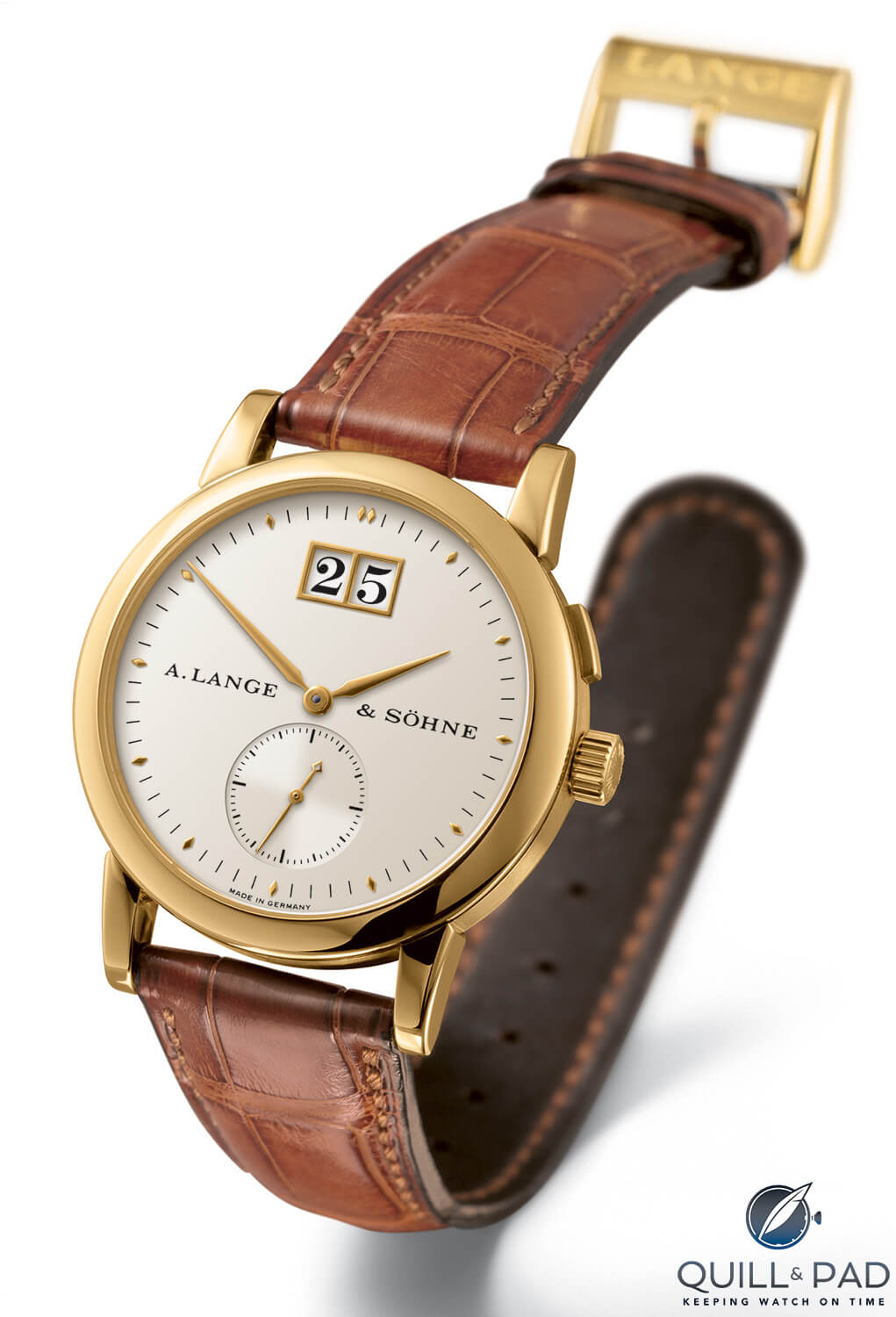
A. Lange & Söhne’s original Saxonia from 1994 in yellow gold; it was available with a choice of gold or blued hands
Please note, though, as this series expresses my personal opinions, it is bound to be highly subjective. Many watch lovers might perceive my impressions in totally different ways, and that’s a good thing since the world of watches has plenty to offer for everyone’s taste, especially at the top end.
A. Lange & Söhne’s Saxonia: in the collection from the beginning
When I first thought about this topic, A. Lange & Söhne’s Lange 1 came to my mind first as the number one sophisticated and legendary timepiece from my home country, Germany. With its unique and distinctive dial layout, including that refined (and for the time novel) large date, it has been the face of this prestigious manufacture since the brand was revived back in 1994. And it has remained the focus of attention ever since.
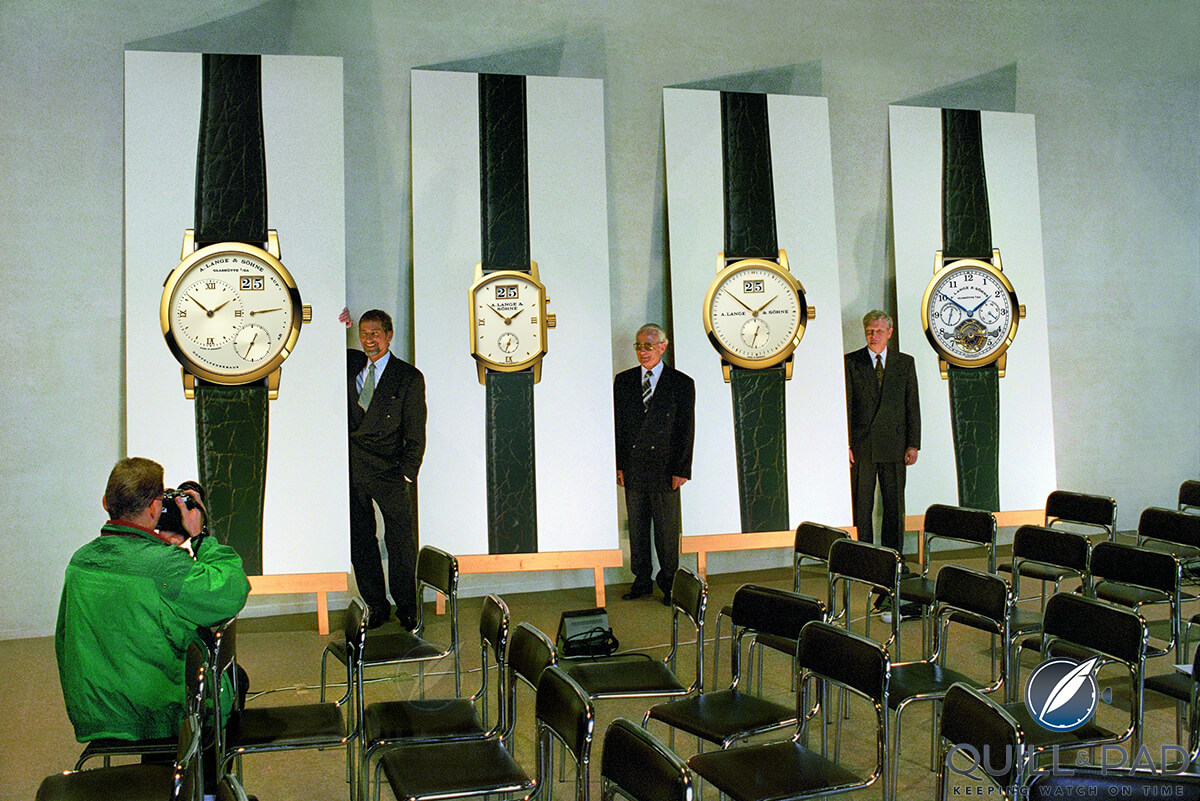
Günter Blümlein, Walter Lange, and Hartmut Knothe pose amid posters of the first four models launched by A. Lange & Sohne on October 24, 1994: Lange 1, Arkade, Saxonia, and Tourbillon Pour le Mérite
As the late Walter Lange and Günter Blümlein introduced the freshly re-founded lineup of modern watches on October 24, 1994 in Dresden, it may have escaped notice that between the Lange 1 and the Tourbillon Pour le Mérite there was this other timepiece christened Saxonia, whose name refers to the federal state in which Glashütte is located: Saxony.
Powered by manually wound manufacture Caliber L941.3, it also featured a large date, though different to that of the Lange 1, which was positioned off-center, the Saxonia’s date was originally placed right at 12 o’clock; a subsidiary seconds subdial was directly across the dial at 6 o’clock for balance.
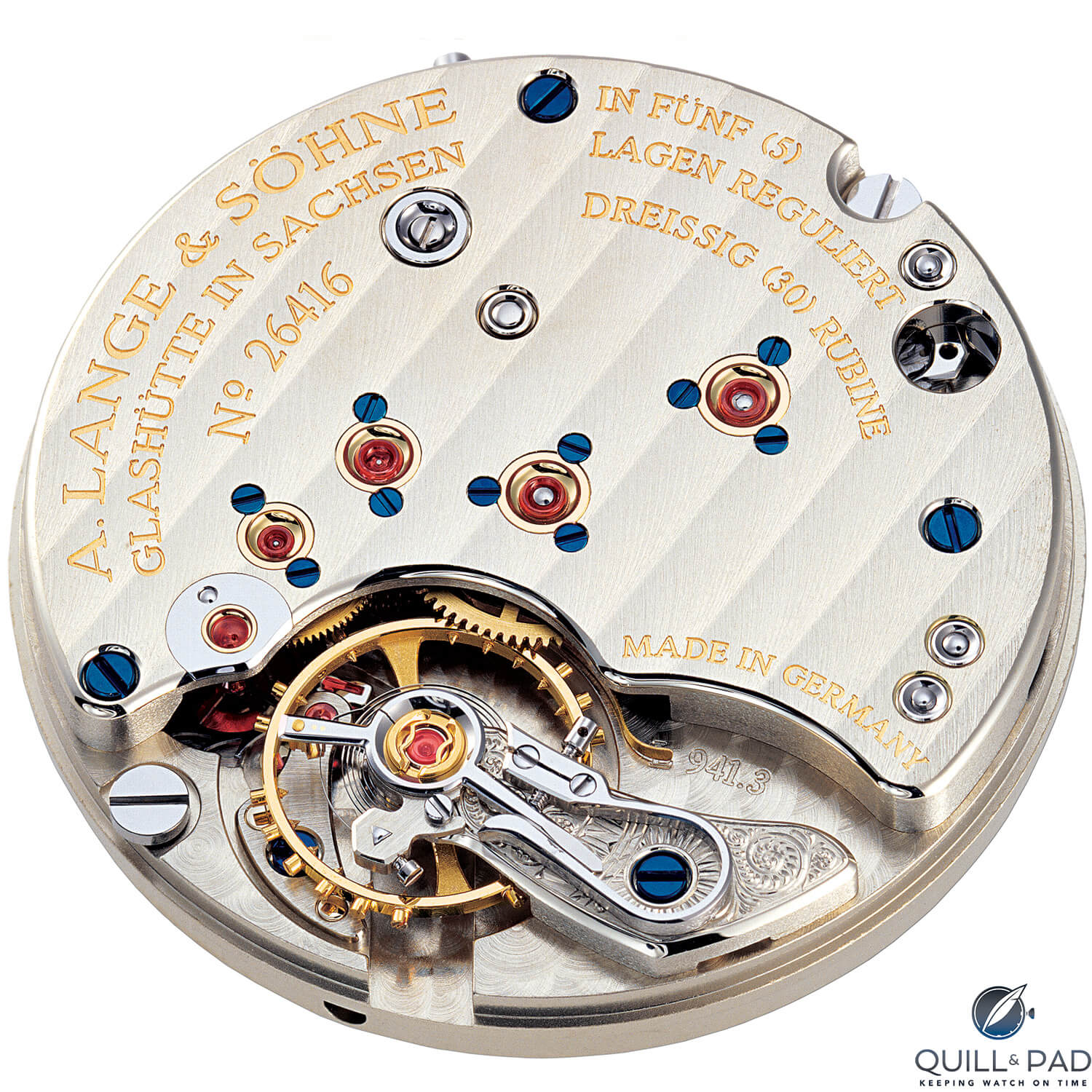
A. Lange & Söhne Caliber L941.3 from 1994’s Saxonia
Foregoing any numerals and displaying applied hour markers in the shape of a rhombus and fine minute marker lines instead, it had a very understated, no-nonsense, and decidedly elegant look that has not changed fundamentally over the course of the years since 1994.
According to the manufacture’s description of its character, until today the model family has been a picture-perfect example of finest Saxon horology with opulent inner beauty – both technically and aesthetically – and a notably minimalist outer appearance.
Saxonian complication as of 2010
The Saxon brand’s prestigious high complication timepieces like tourbillons, split-second chronographs, and the extraordinary watches labeled with the Pour le Mérite predicate were always part of the other product families. It was only in 2010 that a more complicated specimen was added to the Saxonia family: the Saxonia Annual Calendar, which recognizes the differing lengths of the months (but not the leap year).
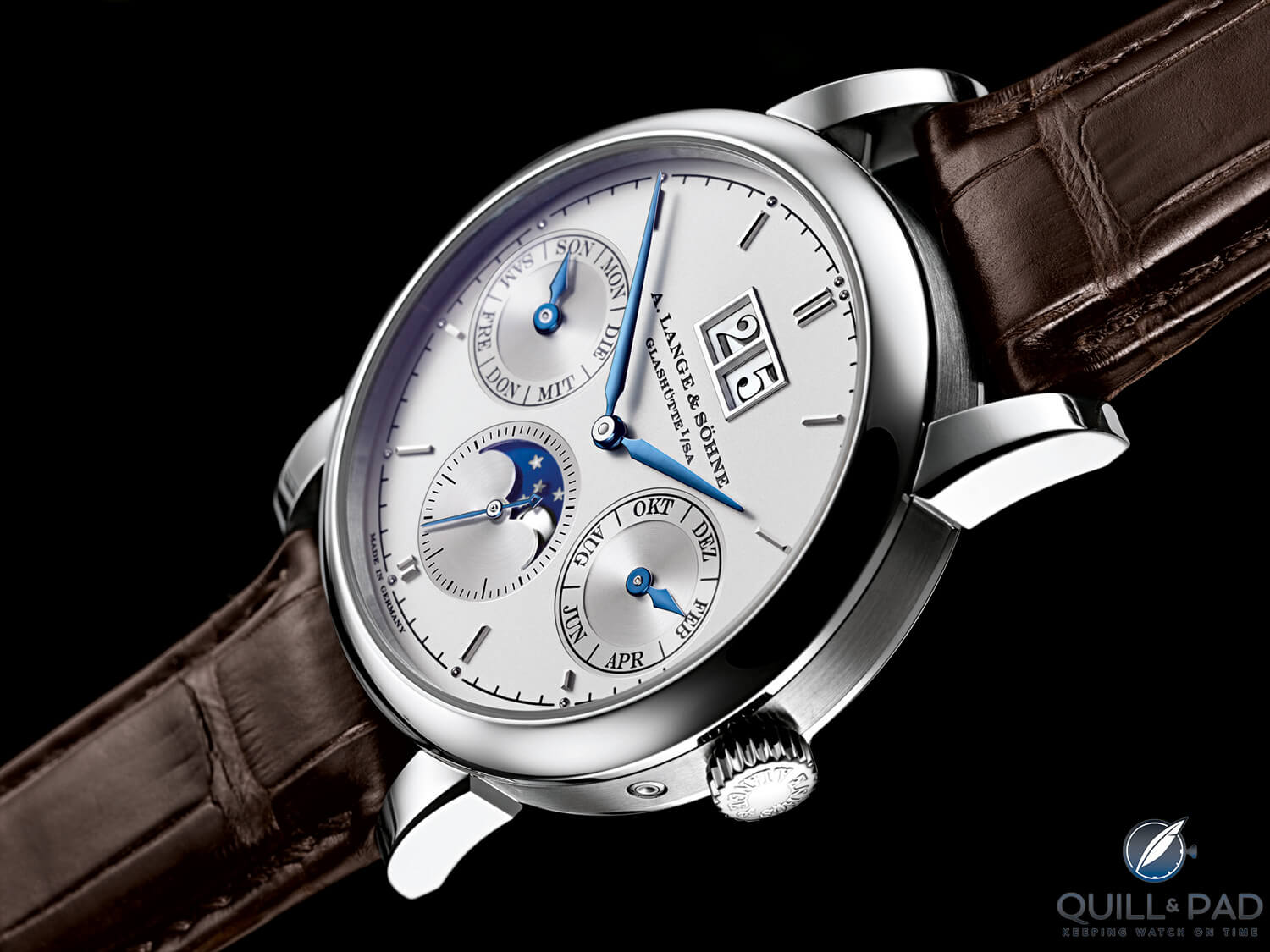
A. Lange & Söhne Saxonia Annual Calendar from 2010
This lack of complication in the line was rectified eventually for good at the SIHH in 2011, where the company presented the Saxonia Automatic, Saxonia Thin, and Saxonia Dual Time. All of these featured updated calibers and a discreet dial makeover that included long gold hour markers moved closer to the edge of the dial. Double indexes were used in various combinations at 3, 6, 9, and 12 o’clock on some of the models.
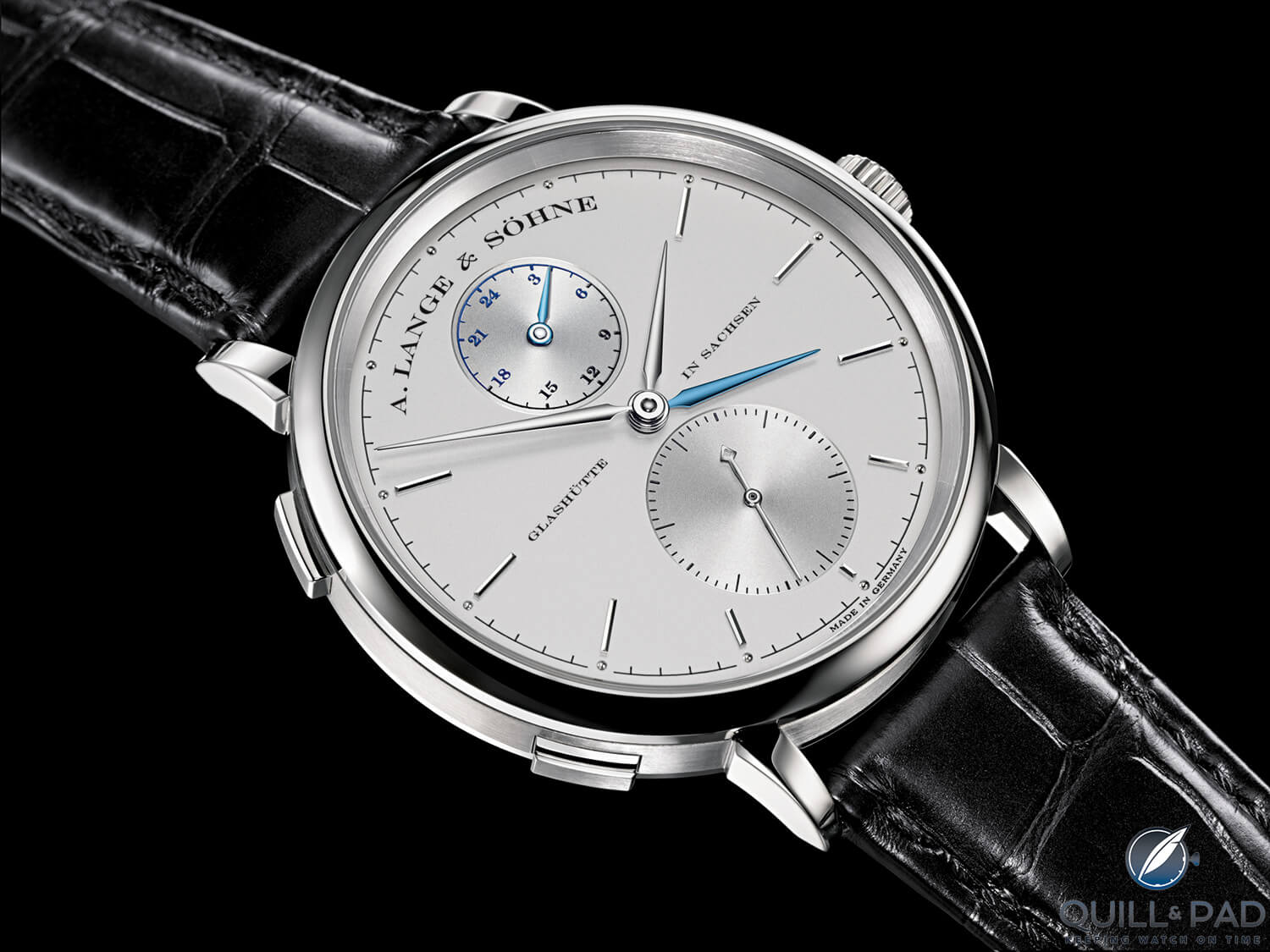
A. Lange & Söhne Saxonia Dual Time from 2011
From a technical point of view, the Saxonia Dual Time was the most interesting timepiece in this new lineup with a refined way of indicating a second time zone provided by automatic manufacture Caliber L086.2.
As long as the watch is in standard mode and not being used to display a second time zone, only the gold hour hand is visible. The other hour hand in blued steel, which indicates the hour of a second time zone, moves in parallel right underneath, completely out of sight.
Once the watch is set to a second time zone, the blued steel hour hand “jumps” into play to indicate the home time. The small blued hand in the 24-hour dial provides information on whether it is day or night.
Although this is a complex GMT timepiece, my favorite model introduced at that time was the Saxonia Thin because it has an understated yet very impressive character. With a diameter of 40 millimeters and a height of only 5.9 millimeters, the two-handed timepiece indicating hours and minutes was the slimmest watch that A. Lange & Söhne had made up to that time.
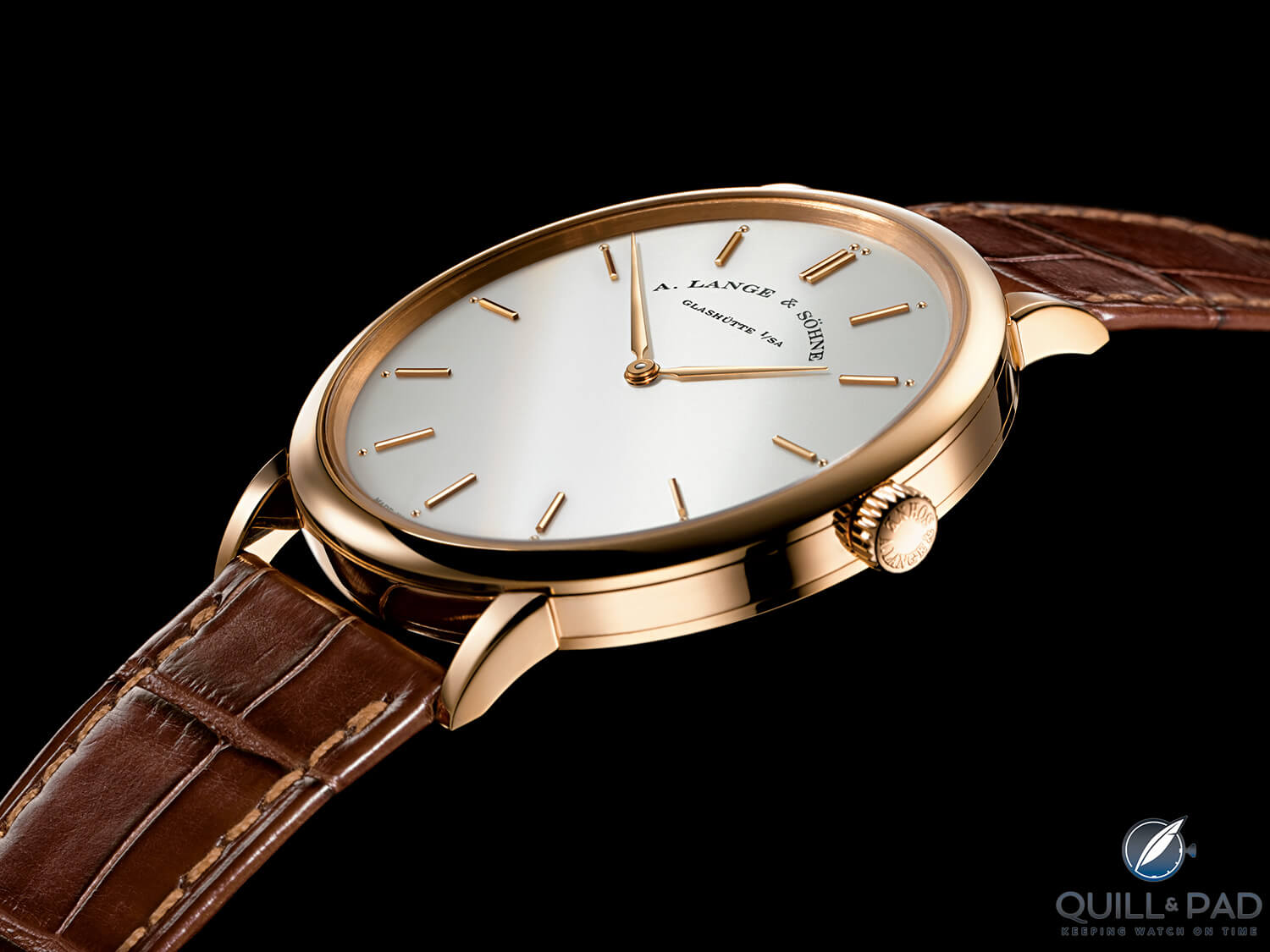
A. Lange & Söhne Saxonia Thin from 2011
With a penchant for thin watches with a minimalist look and for hand-wound movements, it conquered my heart.
The caliber powering the Saxonia Thin is superlative: Caliber L093.1, comprising 167 components, boasts a 72-hour power reserve despite being only 2.9 millimeters high. And as is de rigueur at A. Lange & Söhne, it represents the highest level of traditional craftsmanship and sophisticated technology.
With plates and bridges made of German silver, it features the Lange-typical minutely detailed finishing of all components. Its classic quality hallmarks include the three-quarter plate decorated with Glashütte ribbing, sunburst-brushed winding wheels, three screw-mounted gold chatons, a hand-engraved balance cock, and a hairspring made in house.
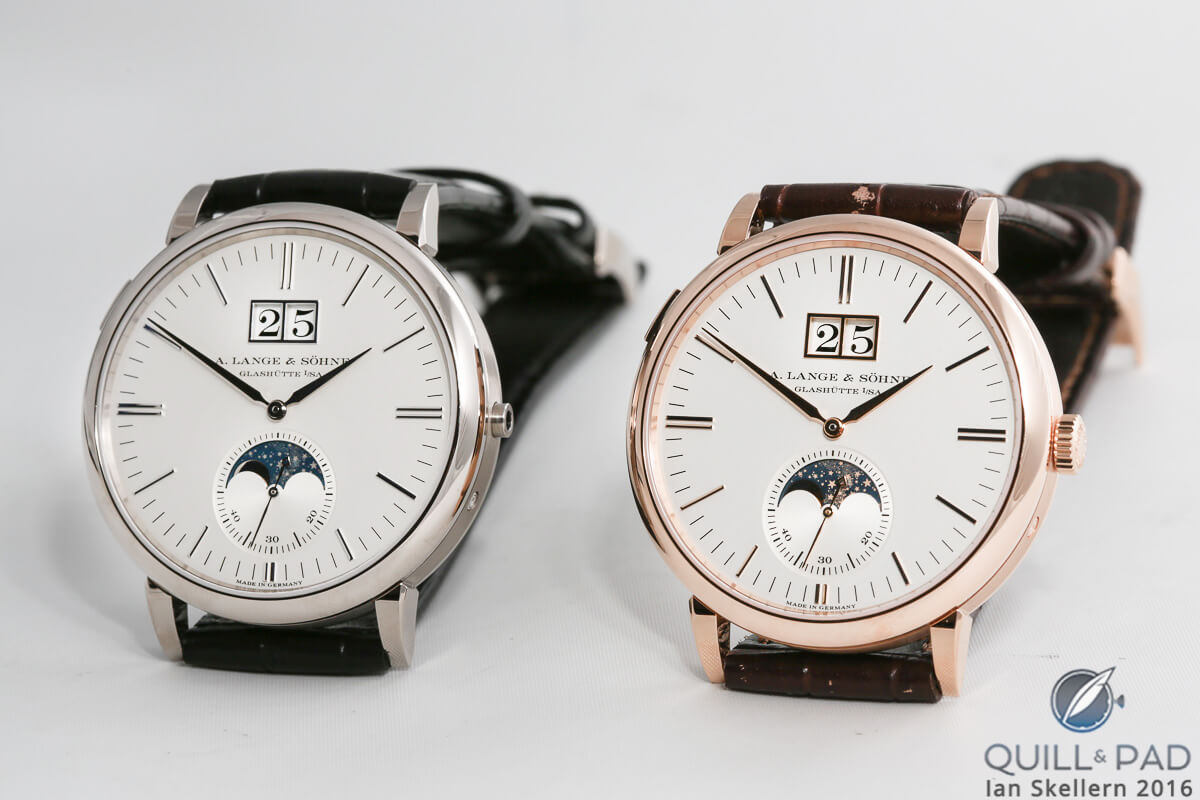
A. Lange & Söhne Saxonia Moon Phase from 2016
The Saxonia Moon Phase finally arrived in 2016, and it was about time as this particular functional display had become something of a hallmark for A. Lange & Söhne by this time; Caliber L.086.5 was the sixteenth movement by A. Lange & Söhne to include the precise display of the earth’s satellite accurate to only one full day’s deviation in 122.6 years. Here, a laser was used to cut the 852 stars seen on the solid gold lunar disk.
In combination with the large date at 12 o’clock, this model’s astronomical visual balance is what constituted its seemingly simply beauty. The large date’s position here naturally pays homage to the original Saxonia model of 1994.
Thin is in: Saxonia Thin as of 2016
In contrast to the first Saxonia Thin, which measured 40 mm in diameter, the new version introduced in 2016, again with a subtle design makeover that slightly extended the hour markers even further toward the dial edge, was additionally offered in a diameter of 37 mm – not only following the more recent trend of smaller case sizes but also making it more acceptable to female customers, thereby offering a unisex timepiece par excellence.
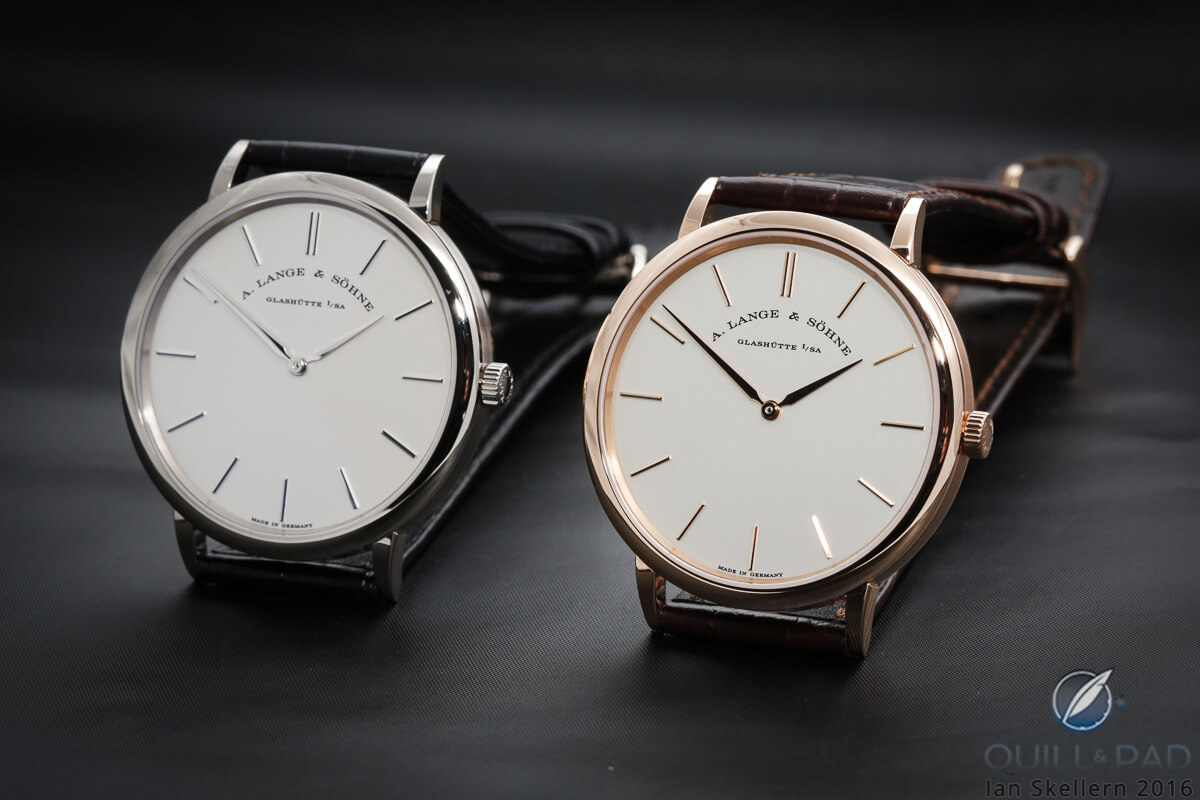
A. Lange & Söhne Saxonia Thin from 2016
This also rings true for 2018’s Saxonia Thin, which is an exceptionally beautiful timepiece and most decidedly unisex, if not leaning toward the more feminine side despite its unchanged sobriety.
Making its debut in a white gold case measuring 39 mm in diameter, it features an intense aventurine dial whose base is crafted in solid silver. The very thin layer of midnight-blue aventurine glass with fused particles of microscopic copper oxide lend the face of this watch a unique shimmer that beautifully emulates a starry night sky.
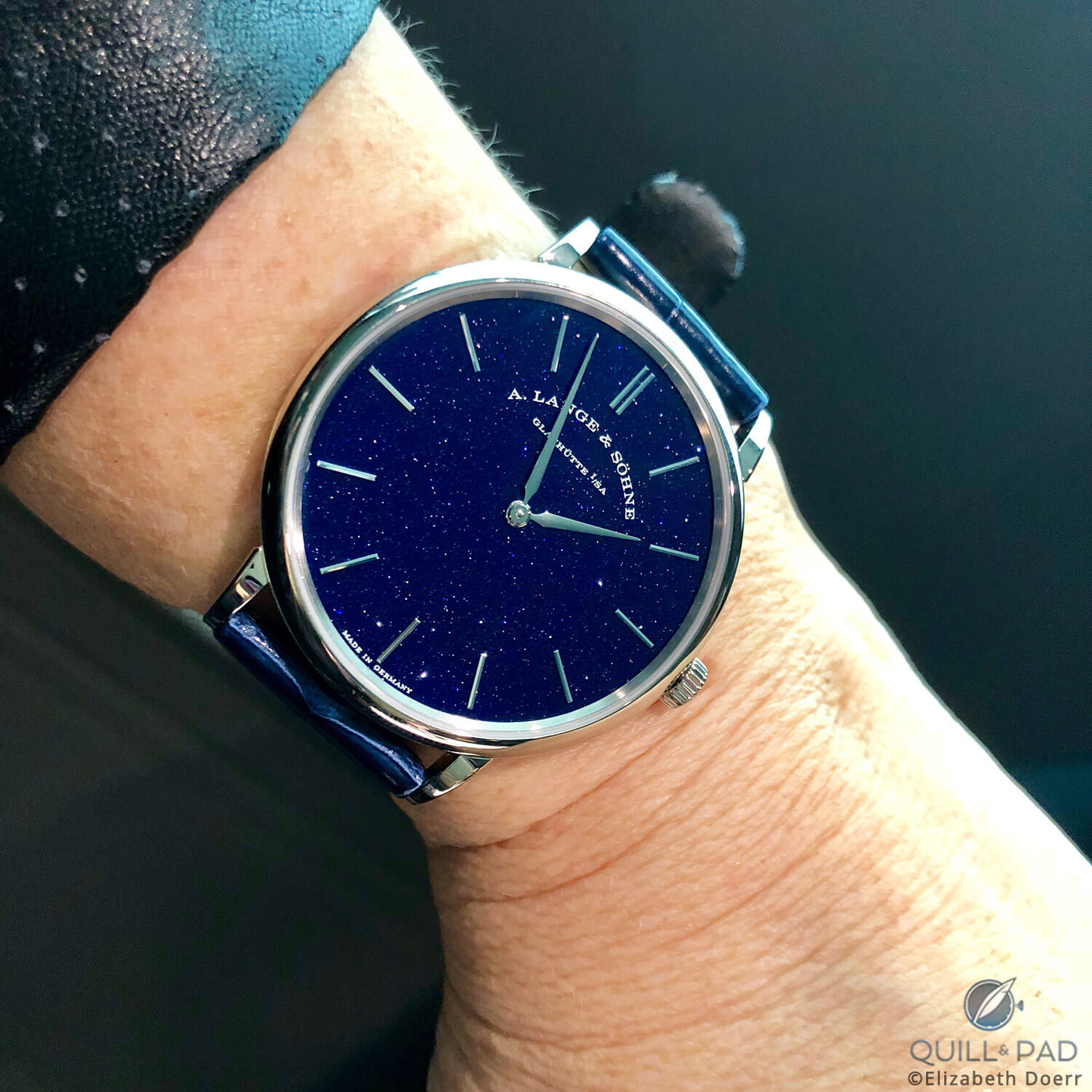
A. Lange & Söhne Saxonia Thin with aventurine dial on the wrist
The result is simply stunning. This unique blue contrasts harmoniously with the white gold case as well as the rhodium-plated gold markers and hands.
Flipping it to the back side, we discover the opulent beauty of aforementioned Caliber L093.1. It is hard to tell which view is more beautiful.
For more information, please visit www.alange-soehne.com/en/timepieces/saxonia/#saxonia.
Quick Facts A. Lange & Söhne Saxonia
Case: 33.9 x 9.1 mm, yellow gold (platinum came a bit later)
Movement: manual winding manufacture Caliber L941.3, 3 Hz/21,600 vph frequency, power reserve 42 hours
Functions: hours, minutes, hacking subsidiary seconds, large date
Year introduced: 1994
Price: $12,400 (yellow gold), $18,600 (platinum)
Quick Facts A. Lange & Söhne Saxonia Dual Time
Case: 40 x 9.1 mm, white or pink gold
Movement: automatic manufacture Caliber L086.2, 3 Hz/21,600 vph frequency, power reserve 72 hours
Functions: hours, minutes, hacking subsidiary seconds; second time zone, 24-hour display, day/night indication
Year introduced: 2011
Price: $28,100 (white gold), $26,900 (pink gold)
Quick Facts A. Lange & Söhne Saxonia Thin 2011
Case: 40 x 5.9 mm, pink gold
Movement: manufacture Caliber L093.1 with manual winding, 3Hz/21,600 vph frequency, power reserve 72 hours
Functions: hours, minutes
Year introduced: 2011
Price: €20,800
Quick Facts A. Lange & Söhne Saxonia Moon Phase
Case: 40 x 9.8 mm, white or red gold
Movement: automatic manufacture Caliber L086.5, 4 Hz/28,000 vph frequency, power reserve 72 hours
Functions: hours, minutes, hacking subsidiary seconds; large date, moon phase display
Year introduced: 2016
Price: €21,600
Quick Facts A. Lange & Söhne Saxonia Thin 2018
Case: 39 x 6.2 mm, white gold
Movement: manufacture Caliber L093.1 with manual winding, 3 Hz/21,600 vph frequency, power reserve 72 hours
Dial: solid silver covered by a thin layer of aventurine
Functions: hours, minutes
Year introduced: 2018
Price: €20,800
Trackbacks & Pingbacks
-
[…] A. Lange & Söhne introduced a very surprising model at SIHH 2018: the Saxonia Thin with aventurine dial. It was so surprising because in its entire history, this brand has never used aventurine or any material even remotely like it. But using it on the Saxonia Thin was a stroke of genius: it became a watch to instantly fall in love with. See more on the Saxonia family’s history and development in Second-Row Stars: A. Lange & Söhne’s Saxonia Model Family. […]
-
[…] You might also enjoy Second-Row Stars: A. Lange & Söhne’s Saxonia Model Family. […]
Leave a Reply
Want to join the discussion?Feel free to contribute!



Great article and a great idea for an article. With the Saxonia series, Lange has managed to create a beautiful line of dress watches, which can hold its own against VC’s Patrimony and Traditionelle, which in my humble opinion are among the most beautiful dress watches. PP which is supposed to be a king in this segment with the Calatrava, has lost its ability or desire with dress watches.
Regarding the Lange Saxonia, I like the Moonphase with Date in Black Dial Rose Gold case, and the new Outsize Date in Black Dial Rose Gold Case, both launched at SIHH 2018.
I will admit a great fondness for the new Saxonia Thin with aventurine dial. It took my breath away!
Thank you for your kind words! I am glad you share my fondness of the Saxonia. As you said, it is a beautiful dress watch that withstands the test of time.
Well written article. Ends a bit abruptly though. Would have been nice to have a summary and closing.
Also some of the pricing needs updating? I thought the Saxonia Moon Phase for example was 29000 USD in the USA and at least 26/27000 EUR in Europe?
I have the 233 and 232 and 1815 plat lim 500 wonderful all now just all the independents so many